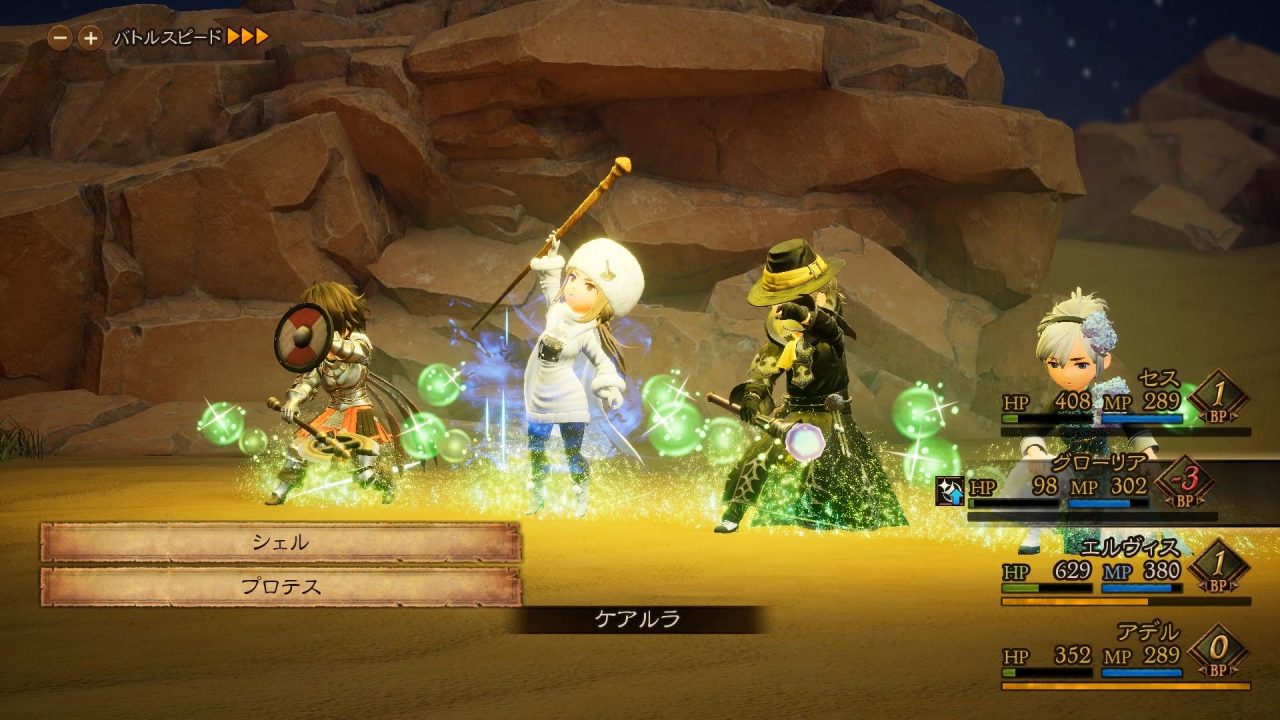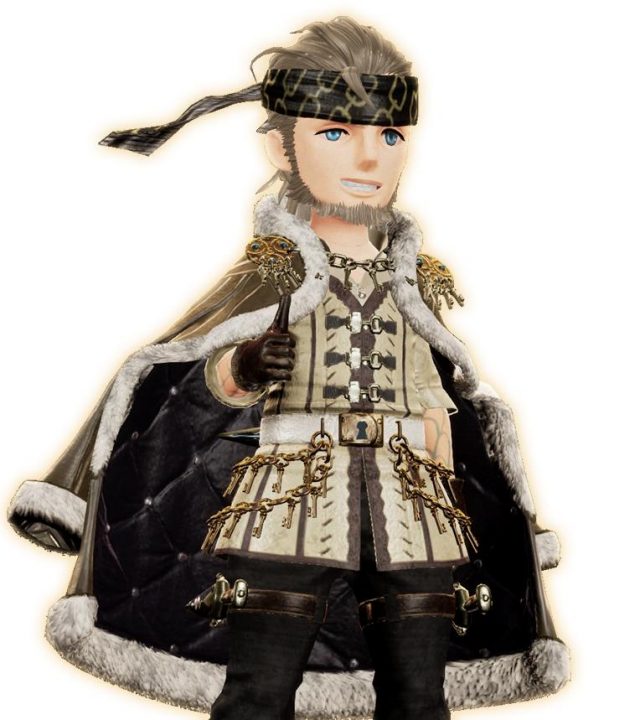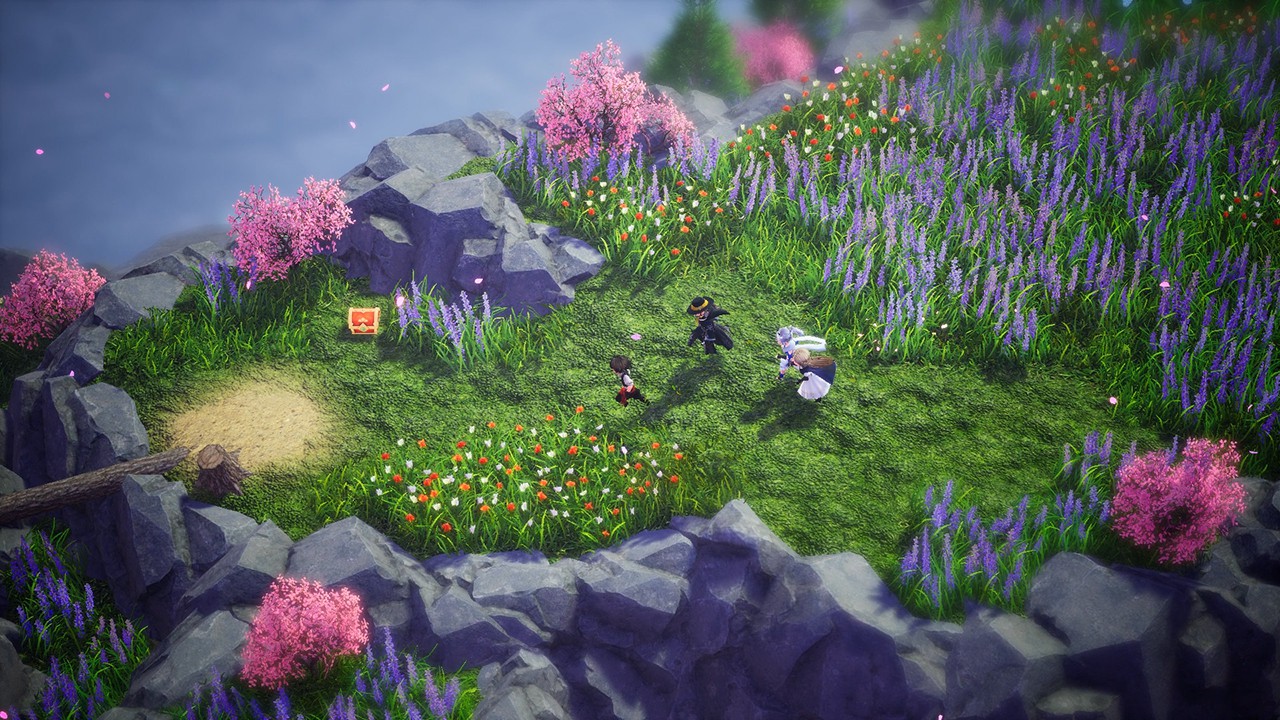See the video version of this review at the end of this page!
Let’s get this out of the way: Bravely Default II is not the second Bravely game. And depending on how you classify Square-Enix games with underlined titles or ones made by Tomoya Asano, Bravely Default II might be the fourth or fifth game in its extended family. But one thing is certain: Bravely Default II is an outstanding new-school RPG with old-school sensibilities that wears its influences on its sleeve.
Another thing Bravely Default II isn’t: a direct sequel to either Bravely Default or Bravely Second. Switch owners need not worry about playing its predecessors to enjoy Bravely Default II, as it shares no characters, locations, or plot threads with those two RPGs. BD2 also abandons a few key gameplay concepts from the original 3DS duo, and I’m not sure it was for the best. I was obsessed with Bravely Default and Bravely Second for over a month each at the time of their releases, so I approached Bravely Default II from the standpoint of a superfan hungry for more. While Bravely Default II is mostly excellent, “mostly” is a loaded adverb.
Seth is a shipwrecked sailor who awashes onto the continent of Excillant following a storm he was unlikely to survive, and shortly afterward meets the (sort of) exiled Princess Gloria of Musa, Gloria’s knight protector Sir Sloan, the traveling scholar Elvis of Wiswald, and Elvis’s mercenary companion Adelle. The five new allies thwart a kidnapping attempt near the kingdom of Halcyonia, and by destiny and/or coincidence decide to work together to battle the warmongering empire of Holograd spreading chaos in Excillant and gather the four elemental crystals to prevent a world-spanning apocalypse.
These two quests (stopping Holograd, finding the crystals) are a Venn diagram that’s just a single circle. The Hologradians are the group that destroyed Gloria’s home kingdom and stole its sacred crystals, and the empire either doesn’t care about or isn’t aware of the crystals’ seal on an evil entity. Elvis is on a journey to find Asterisks, stones of power that grant ancient knowledge to their wielders, and is so chuffed to find three new Asterisks in Halcyonia that he has no qualms helping Gloria accomplish her goals. (He’s easygoing and nonchalant to a fault.) The delightfully sassy Adelle stays with the team out of her obligation to Elvis, but is also searching for her missing sister. Seth has nowhere to go in this new land, and he joins the team out of a… vague sense of justice held by many RPG main characters.

If this tale sounds like several Final Fantasy games, those Asterisks sound like job stones from a few Final Fantasy games, and princess Gloria sounds like at least a couple of RPG maidens (often princesses) duty-bound to save the world, then I share your suspicions. Bravely Default II‘s similarities to Final Fantasy V might be worthy of a separate piece for RPGFan, but are at least worth acknowledging here. More importantly, the gameplay changes from Bravely Default and Bravely Second to Bravely Default II mirror the changes made to Final Fantasy over its first decade.
Bravely Default II abandons the turn-based combat of its predecessors for an active-time battle system with initiative and turn order determined by speed stats and attack delays. This perhaps inflates the importance of job and equipment builds with high Speed, as more actions is always a good outcome. It also incentivizes players not to plan out actions round by round, but instead plan out patterns of attacks, boosts, and heals in a more individual-focused manner because you won’t always have characters with equal numbers of turns. There is also an encumbrance stat not found in previous Bravely games, which drastically slows and weakens your character if you try to equip powerful armor and weapons at too low a level or on an inappropriate job.
Yet, combat retains a signature element of the other Bravely games, the Brave/Default system. Characters can spend BP to Brave and take multiple turns in a row (up to four at once), or Default to guard for one turn and gain an extra BP. Under normal circumstances, each character and enemy gains one BP per turn. If a character has negative BP, they take extra damage and cannot act until they get back to zero BP. Managing your BP is key to success in Bravely Default II, especially since enemies can take advantage of the system as easily as players can.
The job system, not quite inherited wholesale from Bravely Default or Bravely Second, is brilliant in the other games of the BravePath family and is a highlight again in Bravely Default II. The player obtains 24 Asterisks throughout the game (starting with two, then obtaining 19 from story boss fights and three from optional bosses), and across that battle-ready buffet there is a wide variety of skill tinkering and visual interest. Traditional Final Fantasy Black Mages now have stylish coats and fedora hats; the Swordmaster job grants special supermoves and strategies for wielding one sword in two hands or one sword in each hand; and the Oracle combines manipulating time and space with explosive elemental magic. One simple-yet-devastating combination is to equip Thief as a subjob to a high-speed Asterisk like Dragoon or Phantom and deal incredible damage with Godspeed Strike. I won’t overburden you with too many details, but this job system is both deep and fun.

The combat and job systems interact in the Asterisk boss fights, which represent at least 80% of the game’s boss battles and the primary means of obtaining new Asterisks. These fights are spread throughout each chapter (typically 4 or 5 per) and are equally key story moments, battles for survival, and combat puzzles. Determining the Asterisk holder’s pattern and weaknesses while surviving against their offense is a challenge on its own, but Bravely Default II‘s abundance of counter mechanics makes it more challenging than normal. Many bosses in BD2 can activate counterattacks or gain free BP for ALL actions taken by the player, from attacks to defensive spells to item use. Asterisk Holders gain BP so easily during player turns that they act four times in a single turn with startling frequency.
Major boss fights where enemies act four times in a row can be quite challenging (perhaps obviously). The difficulty curve for Bravely Default II spikes at a few of these boss fights — I personally found the final fights of chapters 1 and 3, as well as one specific Asterisk holder in chapter 4, tougher than the final boss. I was able to beat all of the major fights in the game that I attempted (including some but not all of the optional post-game bosses) without extensive level grinding, but a few of them took several tries and adjustments. Bravely Default II’s difficulty feels higher than most turn-based RPGs of its ilk, but never unfair or excessive. It definitely matters that I played the game on Normal mode.
Building a loadout of jobs to suit boss battles is crucial, especially since there are 13 damage types (six weapons and seven magical elements) and every enemy in the game is weak to at least two. Each character has up to five slots for passive skills earned from job levels, plus a chosen sub-job that conveys all the commands learned from that job to the character, which is similar to Final Fantasy V or Final Fantasy Tactics and near-identical to Bravely Default and Bravely Second. But more importantly, the Asterisk fights have a greater story tie-in than in games past.
The 22 major Asterisk holders (There is none for Freelancer, and another is only seen in flashbacks) don’t have their stories end upon their defeat. Bravely Default II has a vast set of side quests, with more generating in every town with every new chapter. Defeated Asterisk holders are often brought back as subjects in these and given small subplots, ranging from redemption to grief to romance. The volume of side quests in Bravely Default II is a little daunting, but a lot of them are well-written, and it was usually fun to revisit the mostly-appealing character designs of those Asterisk bosses.
But maybe the best part of those Asterisk holders is their battle theme. Revo (the music composer for Bravely Default but not Bravely Second) did a fabulous job with the sound design of Bravely Default II, with RPG tunes running the gamut between intense battle themes, energetic character themes, and serene town music. Each town has distinctive character and tone in large part because of the great soundtrack. No complaints here.
Maps and dungeon areas were a weakness in Bravely Default and haven’t changed much in the sequel. The open areas have more details, treasure chests, and hackable trees and grass than before (we’re talking nearly Zelda levels of landscaping opportunities), but nothing more complicated than walking along a river to find a bridge. Dungeon areas are similar, with some pleasant looks but rather boring layouts peppered with local monsters. Gone are the random encounters and adjustable encounter rate of Bravely Default, replaced by enemies visible in the field that can be struck for attack advantage. Monsters will run from you if your level is high and approach when lured by food items; chaining encounters together with food is usually the fastest way to level up quickly in Bravely Default II.

Visually, Bravely Default II is at odds with itself. The textures of the natural features like water and plants are stunningly detailed, but the enemy models and even the main characters on the field look like wrong-sized dolls in a lifelike diorama. The job costume designs are stellar (a personal favorite is the Monk’s flower-patterned shirt) but look like they’re in a different game from those character models.
I won’t spoil anything beyond the first chapter of Bravely Default II‘s story, but tonally it was all over the place. The main plot and the events of the first chapter almost feel too simple and saccharine, as if written 25 years ago, but a few dark twists in the middle chapters are jaw-dropping and there is real character growth from all of the lead roles other than Seth (who is so basic his journey even begins on a dark and stormy night). Bravely Default II has one or two moments of subversion of RPG tropes near the end, but lacks the meta-commentary on RPGs that Bravely Default and Bravely Second had, which I consider a crucial cog in the Bravely machine. I went into the endgame expecting a wild ride but got a slightly bumpy roll to a stop.
I’m not sure how I feel about Bravely Default II, despite playing it for over 50 hours and pondering it for weeks afterward. I unlocked every job, saw multiple endings, and did a few optional postgame boss fights. I love the job system and most of the combat, and I’m willing to overlook a few of the more tedious parts of the game, but some no-brainer pieces are missing: badly-organized side quest lists in a game overstuffed with side quests; odd visual choices that make probably-OK character models look worse; lots of well-communicated information in battle but no way to keep track of enemy counter mechanics; no way to save equipment or job loadouts; and worst of all frustrating load times and frequent slowdown (present in both Switch positions, but especially bad in handheld mode), which is uncharacteristic of both Switch-exclusive games and Square Enix games.
Those visual and technical annoyances and failure to stick the landing properly on its otherwise strong narrative muddied the experience for me. Bravely Default II is a beautiful, interesting throwback RPG that falls short of its full potential because of small details. The 2020 worldwide pandemic during Bravely Default II’s development may be a factor, but I wonder if this twice-delayed game needed a few extra months.



